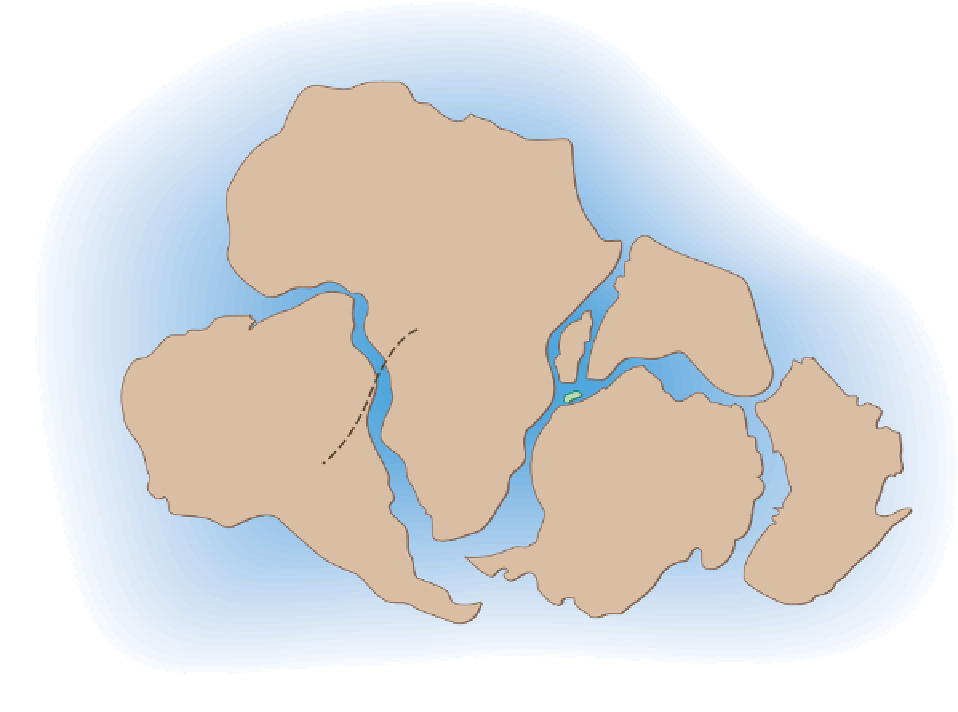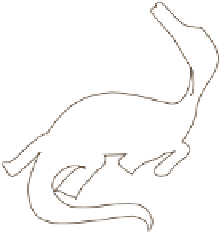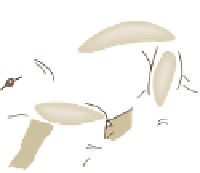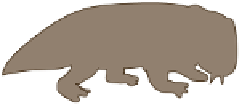Geology Reference
In-Depth Information
Africa
Cynognathus
Lystrosaurus
Cynognathus
Mesosaurus
Glossopteris
India
Lystrosaurus
Glossopteris
South America
Glossopteris
Australia
Cynognathus
Mesosaurus
Lystrosaurus
Glossopteris
Glossopteris
Glossopteris
Antarctica
Mesosaurus
Glossopteris
Lystrosaurus
◗
Figure 2.6
Fossil Evidence Supporting Continental Drift Some of the plants and animals whose fossils are found today
on the widely separated continents of South America, Africa, India, Australia, and Antarctica. During the Late Paleozoic Era,
these continents were joined together to form Gondwana, the southern landmass of Pangaea. Plants of the
Glossopteris
fl ora
are found on all fi ve continents, which today have widely different climates; however, during the Pennsylvanian and Permian
periods, they were all located in the same general climatic belt.
Mesosaurus
is a freshwater reptile whose fossils are found only
in similar nonmarine Permian-age rocks in Brazil and South Africa.
Cynognathus
and
Lystrosaurus
are land reptiles that lived
during the Early Triassic Period. Fossils of
Cynognathus
are found in South America and Africa, whereas fossils of
Lystrosaurus
have been recovered from Africa, India, and Antarctica. It is hard to imagine how a freshwater reptile and land-dwelling reptiles
could have swum across the wide oceans that presently separate these continents. It is more logical to assume that the
continents were once connected.
and Permian-age coal deposits on all fi ve Gondwana conti-
nents. The
Glossopteris
fl ora is characterized by the seed fern
Glossopteris
(Figure 2.1), as well as by many other distinc-
tive and easily identifi able plants. Pollen and spores of plants
can be dispersed over great distances by wind; however,
Glossopteris
-type plants produced seeds that are too large
to have been carried by winds. Even if the seeds had fl oated
across the ocean, they probably would not have remained
viable for any length of time in saltwater.
The present-day climates of South America, Africa, India,
Australia, and Antarctica range from tropical to polar and are
much too diverse to support the type of plants in the
Glossop-
teris
flora. Wegener therefore reasoned that these continents
must once have been joined so that these widely separated lo-
calities were all in the same latitudinal climatic belt (Figure 2.6).
The fossil remains of animals also provide strong evidence
for continental drift. One of the best examples is
Mesosaurus
, a
freshwater reptile whose fossils are found in Permian-age rocks
in certain regions of Brazil and South Africa and nowhere else
in the world (Figure 2.6). Because the physiologies of freshwa-
ter and marine animals are completely different, it is hard to
imagine how a freshwater reptile could have swum across the
Atlantic Ocean and found a freshwater environment nearly iden-
tical to its former habitat. Moreover, if
Mesosaurus
could have
swum across the ocean, its fossil remains should be widely dis-
persed. It is more logical to assume that
Mesosaurus
lived in lakes
in what are now adjacent areas of South America and Africa, but
were once united into a single continent.
Lystrosaurus
and
Cynognathus
are both land-dwelling
reptiles that lived during the Triassic Period; their fossils are
found only on the present-day continental fragments of
Gondwana (Figure 2.6). Because they are both land animals,
they certainly could not have swum across the oceans currently
separating the Gondwana continents. Therefore, it is logical to



































Search WWH ::

Custom Search